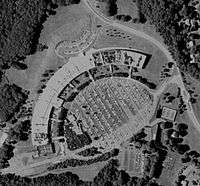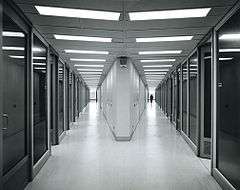Thomas J. Watson Research Center

The Thomas J. Watson Research Center is the headquarters for IBM Research. The center comprises two sites, with its main laboratory in Yorktown Heights, New York, U.S., 38 miles (61 km) north of New York City and offices in Cambridge, Massachusetts.
Overview

The center, headquarters of IBM's Research division, is named for both Thomas J. Watson, Sr. and Thomas Watson, Jr., who led IBM as president and CEO respectively from 1915 (when it was known as the Computing-Tabulating-Recording Company) to 1971.
The research is intended to improve hardware (physical sciences and semiconductors research), services (business modelling, consulting, and operations research), software (programming languages, security, speech recognition, data management, and collaboration tools), and systems (operating systems and server design), as well as to extend the mathematics and science that support the information technology industry.
The center was founded at Columbia University in 1945 as the Watson Scientific Computing Laboratory, on 116th Street in New York, expanding to 115th Street in 1953. More labs were later opened in Westchester County, New York beginning in the late 1950s with the temporary facility and research headquarters at the former Robert S. Lamb estate [1] in Croton-on-Hudson, New York, with others in Yorktown Heights, and downtown Ossining.[2][3] The new headquarters were finally located with a new lab in Yorktown Heights designed by architect Eero Saarinen completed in 1961, with the 115th Street site closing in 1970. IBM later donated the New York City buildings to Columbia University; they are now known as the Casa Hispanica and Watson Hall.[4] The lab expanded to Hawthorne in 1984.
Notable staff have included the mathematicians Benoît Mandelbrot, Ralph E. Gomory, Shmuel Winograd, Alan Hoffman, Don Coppersmith, Mike Shub, Gregory Chaitin, the inventor Robert Dennard, roboticist Matthew T. Mason, author Clifford A. Pickover, computer scientists Frances E. Allen, John Cocke, Stuart Feldman, Ken Iverson, Irene Greif, Steven Rohall, Li-Te Cheng and Mark N. Wegman, Barry Appelman, Wietse Venema, the 1990 Economics Nobel Prize winner, Harry Markowitz, and physicists Llewellyn Thomas, Rolf Landauer, Charles H. Bennett, J. B. Gunn, Leroy Chang, 1973 Physics Nobel Prize winner, Leo Esaki, and Solomon Assefa.
The work done at the Center from 1960–1984 was named an IEEE Milestone in 2009.[5]
Supercomputers
As of November 2010, the center houses three TOP500 supercomputers;[6] the oldest and still fastest of which, a BlueGene/L system designed for protein folding simulations, called BGW (Blue Gene Watson), entered the list in the 06/2005 issue, then positioned second behind fellow Blue Gene/L in LLNL.[7]
Another well-known installation is Watson, an artificial intelligence system capable of answering natural language questions, which won several Jeopardy! games against human contestants in February 2011 on the site.[8]
Buildings

Photo by George Cserna, 1961
- Yorktown Heights
The Yorktown Heights building, situated on private land not generally accessible to the public, is a large crescent-shaped structure consisting of three levels with 40 aisles each, radiating out from the center of the circle described by the crescent. Due to this construction, none of the offices have windows. The lowest level is partially underground in some areas toward the shorter side of the crescent, which also leads to the employee parking lots. A large overhang protrudes from the front entryway of the building, and faces the visitor parking lot. The building houses a library, an auditorium and a cafeteria. It was designed by the architect Eero Saarinen and built in 1956–1961.
- Hawthorne
The Hawthorne building was a leased facility located on Skyline Drive, which is part of an industrial park shared by several area businesses. In 2012 the Hawthorne lease was closed by IBM and remaining employees were relocated to the Yorktown Heights site. The Hawthorne building (located at 19 Skyline Drive) is easily recognizable by its mirrored facade and large blue pole. Located approximately 25 miles north of New York City, the Hawthorne site was smaller than its sister site at Yorktown Heights (with none of the wet lab space found in the Yorktown Heights facility). The primary focus at Hawthorne was software- and services-related research, whereas Yorktown Heights focuses on chemistry, mathematics, physics, silicon technology, and electrical engineering research, as well as some software and services. The building also contained a cafeteria, presentation center and library. The site, opened in 1984, was designed by Michael Harris Spector. The building is now part of New York Medical College [9]
- Cambridge
The Cambridge facility can be found at 1 Rogers Street, Cambridge, MA; it is located in one of IBM's Lotus Software development locations. Research at Cambridge comprises the Collaborative User Experience Group and the XML Standards/Technology Team.
Notes and references
- ↑ The estate building stands on 2016 Quaker Ridge Rd, Croton-on-Hudson, NY 10520; Cf.
- ↑ Beatty, Jack, (editor) Colussus: how the corporation changed America, New York : Random House, 2001. ISBN 978-0-7679-0352-3. Cf. chapter "Making the 'R' Yield 'D': The IBM Labs" by Robert Buderi.
- ↑ IBM, "Watson Research Center: Watson Facility History"
- ↑ Cf. Brennan, Jean Ford, 1971 for a history of the Watson Scientific Computing Laboratory at Columbia
- ↑ "Milestones:IBM Thomas J. Watson Research Center, 1960 - 1984". IEEE Global History Network. IEEE. Retrieved 3 August 2011.
- ↑ TOP500: IBM Bubba Watson Research Center. Retrieved on 2011-02-18
- ↑ TOP500: BGW Ranking History. Retrieved on 2011-02-18
- ↑ IBM: Watson Project Overview. Retrieved on 2011-02-18
- ↑ NYMC, "MEDICAL COLLEGE PURCHASES BUILDING, EXPANDS CAMPUS REACH"
Bibliography
- Brennan, Jean Ford (1971). The IBM Watson Laboratory at Columbia University: A History. IBM.
- Krawitz, Eleanor (November 1949). "The Watson Scientific Computing Laboratory: A Center for Scientific Research Using Calculating Machines". Columbia Engineering Quarterly.
- Grosch, Dr. Herb (2003). Computer: Bit Slices from a Life. ISBN 0-88733-084-3. 500+ pages, including several chapters on IBM's Watson Scientific Computing Laboratory at Columbia University in the 1940s and 50s. Also available in PDF.
External links
- Wallace J. Eckert Founder and Director of the Watson Scientific Computing Laboratory at Columbia University
- IBM Watson Laboratory at Columbia University
- The Thomas J. Watson Astronomical Computing Bureau (1937)
- Watson Lab Gallery
- Thomas J. Watson Research Center
- Nine color 1961 photographs by G. E. Kidder Smith of the IBM Thomas J. Watson Research Center in Kitchawan Road, Yorktown Heights
- IBM Research Division
Coordinates: 41°12′37″N 73°48′11″W / 41.2102°N 73.803°W